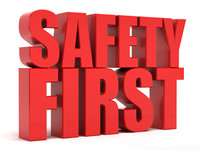Categories PF Stuff Lye Safety
Lye Safety

Sodium Hydroxide & Potassium Hydroxide
Safety & Information Pack
Before you open the packs....
A quick word about sodium and potassium hydroxides…..we start with the bit that usually scares people off trying to make soap from scratch. Sodium and potassium hydroxides are caustic and can cause burns if not handled correctly. There will be NO sodium or potassium hydroxide left in the soap at the end of the process, but it is necessary to use it as it is this product that will turn the fats, oils & butters into a beautiful soap. Use sodium hydroxide for hard bars of soap and potassium hydroxide for liquid soap.
Sodium or potassium hydroxide will be mixed with water for the soap making process. The sodium or potassium hydroxide and water combination is also known as the 'lye' solution.
When mixing the lye solution, you will be creating unpleasant fumes so it is always best to do this in a well ventilated room, but not one with a howling gale blowing through it (which may cause the sodium or potassium hydroxide granules to blow around).
Read the safety instructions that will be on the container you purchased your sodium or potassium hydroxide in and follow those instructions carefully. The instructions may recommend the use of protective goggles and gloves.
Read the safety instructions on the sodium or potassium hydroxide container again in case you missed anything the first time.
What does sodium hydroxide look like?
Sodium hydroxide is white and it usually takes the form of tiny white grains or pellets. The chemical term for sodium hydroxide is NaOH.
What does potassium hydroxide look like?
Potassium hydroxide is off white and it usually takes the form of flat flakes or pellets. The chemical short term for potassium hydroxide is KOH.
How shall I store it?
When not in use, keep the unused sodium or potassium hydroxide in the container it came in, somewhere dry and at room temperature. Make sure the lid is tightly fastened. Keep out of reach from children and pets.
Make sure the container is labeled correctly so that anyone picking up the container would know what it contains and that the contents are dangerous and corrosive.
Never store the sodium or potassium hydroxide in an unmarked container.
Note - when opening the container you may find that the sodium or potassium hydroxide granules or flakes have clumped together. This clump will break up and dissolve in water as normal.
What if I spill some solution?
Sweep the grains or pellets into an ash pan and dispose of down the sink running the cold water tap to flush them down the drain.
If you have splashed some lye solution, use thick kitchen paper towels to soak up the solution. Make sure you are wearing rubber or nitrile gloves so that your hands do not come into direct contact with the solution.
Dispose of the paper towels sensibly by wrapping them in a couple of layers of polythene bag and do not allow anyone else to come into contact with them.
Wash the area where the solution was spilled until you are sure there is not sodium or potassium hydroxide left in that area.
What shall I wear when making my lye?
The safety instructions advise that you should wear safety glasses.
You should also wear a pair of gloves (household rubber gloves, nitrile gloves etc.) that allow you to have complete dexterity and control over what you are doing.
Wearing an overall or an apron is sensible to avoid any tiny splashes burning your clothes.
Wear long sleeves to avoid any splashes going on your arm, and always wear full shoes, not open-toed sandals in case any is spilled.
What if I do splash some on me?
If you do splash any lye solution on you, rinse the affected skin under cold running water for at least 20 minutes. Seek medical advice if at all concerned about the burn.


Chemical Safety Data: Sodium Hydroxide
|
Common synonyms |
Caustic soda, soda lye |
|
Formula |
NaOH |
|
Physical properties |
Form: White semi-transparent solid, often supplied as pellets weighing about 0.1g |
|
Principal hazards |
Contact with the eyes can cause serious long-term damage |
|
Safe handling |
Always wear safety glasses. Do not allow solid or solution to come into contact with your skin. When preparing solutions swirl the liquid constantly to prevent "hot spots" developing. |
|
Emergency |
Eye contact: Immediately flush the eye with plenty of water. Continue for at least ten minutes and call for immediate medical help. |
|
Disposal |
Small amounts of dilute sodium hydroxide can be flushed down a sink with a large quantity of water, unless local rules prohibit this. Larger amounts should be neutralised before disposal. |
|
Protective equipment |
ALWAYS wear safety glasses when handling sodium hydroxide or its solutions. If you need gloves, neoprene, nitrile or natural rubber are suitable for handling solutions at concentrations of up to 70%. |


Chemical Safety Data: Potassium Hydroxide
|
Common synonyms |
Potash, caustic potash |
|
Formula |
KOH |
|
Physical properties |
Form: Off white semi-transparent solid, often supplied as pellets or flakes weighing about 0.1g |
|
Principal hazards |
Contact with the eyes can cause serious long-term damage |
|
Safe handling |
Always wear safety glasses. Do not allow solid or solution to come into contact with your skin. When preparing solutions swirl the liquid constantly to prevent "hot spots" developing. |
|
Emergency |
Eye contact: Immediately flush the eye with plenty of water. Continue for at least ten minutes and call for immediate medical help. |
|
Disposal |
Small amounts of dilute potassium hydroxide can be flushed down a sink with a large quantity of water, unless local rules prohibit this. Larger amounts should be neutralised before disposal. |
|
Protective equipment |
ALWAYS wear safety glasses when handling potassium hydroxide or its solutions. If you need gloves, neoprene, nitrile or natural rubber are suitable for handling solutions at concentrations of up to 70%. |

